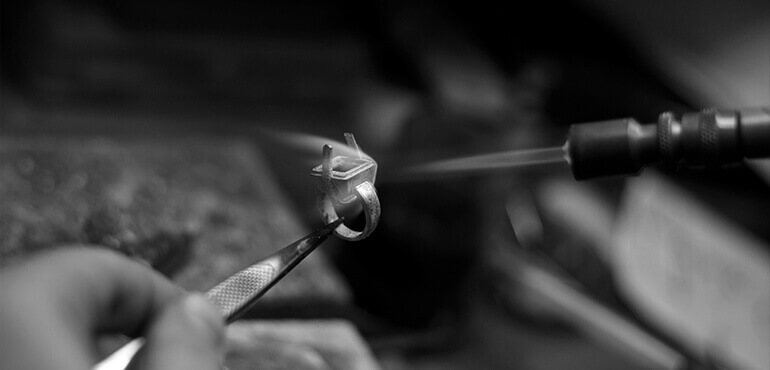Diamond Clarity

At A Glance
- Clarity refers to the naturally occurring imperfections in a diamond, such as blemishes or inclusions.
- For clarity grades from F to VS, inclusions, or internal flaws, are not visible to the naked eye.
- "Eye-clean" diamonds are those that possess imperfections that are not detectable to the unaided eye, including some diamonds graded as SI in clarity.

Diamond Clarity
A diamond's clarity is an important characteristic to consider when purchasing a diamond, as the clarity grade can greatly influence the pricing. However, clarity will only affect the actual appearance of the diamond to the naked eye once you start to explore grades below VS. Other characteristics of the diamond, such as its cut quality and color, will also contribute to how visible or apparent flaws will appear. Thus, it is important to note that you can find an exceptional quality diamond in various clarity grades.
Diamonds are born deep within the earth, under extreme amounts of heat and pressure, which consequently create birthmarks or flaws in most diamonds. Every diamond's flaws are unique, enough so that they even can aid in identifying one diamond from another, like a finger print. GIA certificates actually include a plot or details of the particular characteristics of a diamond's imperfections, which can be used as assurance you receive the diamond you paid for. Some imperfections are created during development and others can be created during the cutting or polishing process. The clarity of a diamond directly refers to the absence or lack of these naturally occurring imperfections. These flaws are distinguished as either internal or external, most often referred to in the following types:
- Blemishes: Flaws that exist on the surface of the diamond. (i.e. Scratches, chips, pits, etc.)
- Inclusions: Flaws that exist inside the diamond. (i.e. Air bubbles, non-diamond minerals, cracks, etc.)
How is the clarity of a diamond graded?
Diamonds are graded on a scale developed by the GIA that contains 11 different grades, ranging from Flawless to Included 3. In order to establish the proper grade, diamonds are examined under a 10x magnification to identify any inclusions or external flaws. It is important to remember that most inclusions and blemishes do not affect the diamond's unmagnified appearance, only its monetary value.

Clarity Grade Definitions
F (Flawless)
The highest clarity grade existing, F ensures a diamond is completely flawless. Extremely rare and valuable, a diamond with this grade has no internal flaws, or inclusions, and no external blemishes when inspected by an expert gemologist. The rarity of these diamonds is exponential, thus they are significantly more expensive. F is the clarity grade that ensures a flawlessly beautiful and tremendously rare diamond; the very best that money can buy.
IF (Internally Flawless)
The second highest clarity grade, IF ensures that a diamond has absolutely no internal flaws, or inclusions. They will, however, have some external flaws or blemishes, but these flaws are only visible when inspected by an expert gemologist and are not perceivable by the naked eye. Also, mostly the external flaws can be removed by further polishing of the diamond. To the naked eye, a diamond of this grade will appear flawless. IF is an exceptional clarity grade; both rare and marvelous quality.
VVS1-VVS2 (Very Very Slightly Included 1-2)
The third highest clarity grade, VVS1-VVS2 ensures a diamond that appears flawless, but has some infinitesimal inclusions or internal flaws. These inclusions can only be detected by an expert gemologist under 10x magnification and even then are difficult to distinguish. When inspected professionally from the top of the diamond usually no inclusions are detectable, but can be identified from the bottom of the diamond. To the naked eye, this diamond will appear flawless and its grade only affects its price, but not its appearance. VVS1-VVS2 is an excellent clarity grade choice, offering both superb quality and value.
VS1-VS2 (Very Slightly Included 1-2)
The clarity grade VS1-VS2 ensures a diamond that appears flawless to the naked eye, but has some minute inclusions or internal flaws. These inclusions can only be detected if you utilize 10x magnification and even then are difficult to distinguish. To the naked eye, this diamond will appear flawless and its grade only affects its price, but not its appearance. VS1-VS2 is a very good clarity grade choice, offering both quality and value.
SI1-SI2 (Slightly Included 1-2)
The clarity grade SI1-SI2 ensures a diamond that has only slight inclusions or internal flaws. These inclusions usually are only visible if you utilize 10x magnification, but possibly may be detected by the naked eye as well. However, many diamonds of this grade have no visible flaws to the unaided eye, thus can be an affordable alternative that still buys a beautiful diamond. SI1-SI2 is a good clarity grade choice, catering to a consumer's budget and still offering a quality diamond.
I1 (Included 1)
The clarity grade I1 ensures a diamond that has fairly visible inclusions or internal flaws. These inclusions are visible with or without 10x magnification, thus these flaws are detectable to the naked eye. Before purchasing you must realize that the internal and external flaws will be perceivable to anyone who looks upon the diamond. I1 is a fair clarity grade choice and although much less expensive, the flaws of the diamond will be obvious.
I2-I3 (Included 2-3)
The clarity grade I2-I3 ensures a diamond that has visible inclusions or internal flaws. These inclusions are visible with or without 10x magnification, thus these flaws are detectable to the naked eye. Before purchasing a diamond with this grade, you must realize that the internal and external flaws will be perceivable to anyone who looks upon the diamond. I2-I3 is a poor clarity grade choice and although much less expensive, the flaws of the diamond will be obvious.
What clarity grade is right for me?
When choosing a clarity grade, your first consideration should be to find a happy medium between your budget and the quality of the diamond you choose. The higher the clarity grade, the more expensive and rare it becomes. A Flawless diamond is truly stunning and extremely rare; so rare in fact that most jewelers have never even seen one in person. However, a diamond doesn't need to be Flawless in order to be truly spectacular.
Keep in mind that it isn't until you reach the SI grades and below that the diamond's unmagnified appearance will even be affected. Being that it isn't likely that anyone will be carrying around a 10x magnifying loupe to inspect your diamond, you can easily save money by purchasing a diamond that is flawless to the unaided eye. Clarity grades from F-VS have no visible flaws to the naked eye, thus diamonds with VVS and VS grades are excellent choices that ensure both quality and value.
clarity explained easy

Ultimately, we recommend you at least buy a diamond that is "eye-clean", meaning that it has no imperfections that are perceivable to the unaided eye. Diamonds that are "eye-clean" with no inclusions visible through the crown are much less expensive, usually ranging in the SI1 and SI2 categories. They provide a great opportunity to purchase a diamond that is much more affordable, while still being stunning.
Due to the fact that flaws in diamonds with a I1-I3 clarity possess flaws that are noticeable without any magnification, you must realize that some people will immediately see the flaws. These imperfections can be quite obvious; however, in all fairness not all flaws are equally visible. Thus, if you do choose a diamond with a clarity grade of I1-I3, we recommend viewing the diamond before purchasing or having a jeweler examine the diamond to reveal exactly how evident the flaws will be once placed in the ring.









 Three Stone Rings
Three Stone Rings Side Stone Rings
Side Stone Rings Halo Rings
Halo Rings Vintage Rings
Vintage Rings Solitaire Rings
Solitaire Rings Yellow Gold Rings
Yellow Gold Rings White Gold Rings
White Gold Rings Pave Rings
Pave Rings Channel Rings
Channel Rings Simple Rings
Simple Rings Round Rings
Round Rings Princess Rings
Princess Rings Cushion Rings
Cushion Rings Emerald Rings
Emerald Rings Asscher Rings
Asscher Rings Radiant Rings
Radiant Rings Oval Rings
Oval Rings Pear Rings
Pear Rings Marquise Rings
Marquise Rings Heart Rings
Heart Rings 14k White Gold
14k White Gold 14k Yellow Gold
14k Yellow Gold 18k White Gold
18k White Gold 18k Yellow Gold
18k Yellow Gold Platinum
Platinum Channel Bands
Channel Bands Pave Bands
Pave Bands Prong Bands
Prong Bands Eternity Bands
Eternity Bands Diamond Bands
Diamond Bands
